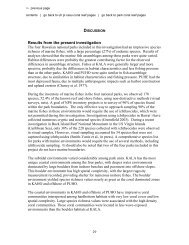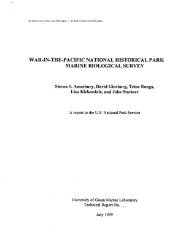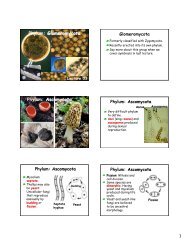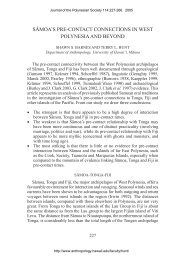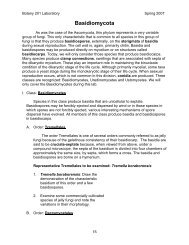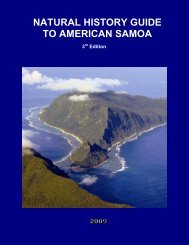american samoa - University of Hawaii at Manoa Botany Department
american samoa - University of Hawaii at Manoa Botany Department
american samoa - University of Hawaii at Manoa Botany Department
- No tags were found...
You also want an ePaper? Increase the reach of your titles
YUMPU automatically turns print PDFs into web optimized ePapers that Google loves.
Veget<strong>at</strong>ion TrendsIn 1992, Biosystems Analysis, Inc. surveyed this wetland as part <strong>of</strong> its prepar<strong>at</strong>ion <strong>of</strong> aComprehensive Wetlands Management Plan. Biosystems Analysis, Inc. recorded mangroves <strong>at</strong>the mouth <strong>of</strong> Fa<strong>at</strong>afe Stream and described the southeast wetland as a freshw<strong>at</strong>er wetland withcoconut trees.The most significant change to the wetland has been a reduction in size. In 1992, BiosystemsAnalysis estim<strong>at</strong>ed th<strong>at</strong> the southeast wetland comprised about 18.5 acres. Between 1992 and1999, about 2 to 3 acres have been lost by land fill activities associ<strong>at</strong>ed with the development<strong>of</strong> the Mormon and Methodist church complexes.Taro cultiv<strong>at</strong>ion was no longer present within the disturbed marsh in November 1999. Formertaro cultiv<strong>at</strong>ion may have stopped due to the taro blight th<strong>at</strong> occurred in the early 1990’s.A change in the mangrove forest, just upstream <strong>of</strong> the Fa<strong>at</strong>afe Stream mouth, has occurredsince 1992. Biosystems noted the presence <strong>of</strong> both red and oriental mangrove. In November1999, only oriental mangrove was recorded. This lower stream area is now best classified as afreshw<strong>at</strong>er swamp forest.AQUATIC FISH AND INVERTEBRATESGeneralOn November 4, 1999, Charles Chong <strong>of</strong> thePPC field survey team made observ<strong>at</strong>ions <strong>of</strong>aqu<strong>at</strong>ic fish and invertebr<strong>at</strong>es along the lower850 feet <strong>of</strong> Fa<strong>at</strong>afe Stream. His observ<strong>at</strong>ionsare summarized in the following paragraphs.Just upstream <strong>of</strong> the stream mouth and mainshoreline roadway, there was a small estuaryth<strong>at</strong> was fed by surface run<strong>of</strong>f from Fa<strong>at</strong>afeStream, as well as a nearby spring. During thetime <strong>of</strong> the survey, stream flow was estim<strong>at</strong>edto be less than 1 cfs.FishFishes observed in the lower estuary possessed a high species diversity and abundance <strong>of</strong>macr<strong>of</strong>auna. Mugil, Chanos, Periopthalmus, Eleotris, Kuhlia and Stenogobius weredocumented within the estuary.Exotic Poecilia were abundant in the estuary and along the stream. Stiphodon, Anguilla, andKuhlia spp. were common <strong>at</strong> lower and higher stream elev<strong>at</strong>ion.American Samoa Wetland/Stream Restor<strong>at</strong>ion and Enhancement PlanFebruary 2001, V<strong>at</strong>ia Wetland, Page 5-7




